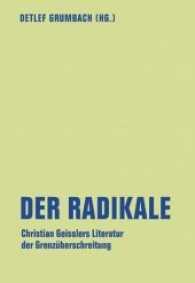Full Description
The artistic eminence of JosÉ Clemente Orozco (1883-1949) is such that he has been called "the greatest painter the Americas have produced." In his Autobiography he also attains literary distinction. He is a writer who recounts the history of his period from a personal point of view and yet scarcely mentions himself. He is an observer who writes about the history of his country and of his country's art, yet makes his own character implicit in the narrative.
The character that emerges is charming. It is that of a man strong but retiring, sharply critical of what he disapproves yet generous in praise of what he admires, decided in his views but modest in his assumptions and given to understatement in describing his own activities, averse to war and political struggle yet eager for conflict of ideas, always dedicated to the welfare of humanity.
Through the details of day-by-day living, he presents the panorama of the Mexican Revolution and of events in other parts of the world to which he traveled. His is a personal story of the Revolution, giving his reactions (as those of any common man) to the barbarities of war: "Insolent leaders, inflamed with alcohol, taking whatever they wanted at pistol point. . . . By night in dark streets the sound of gunplay, followed by screams, blasphemies, and vile insults. Breaking windows, sharp blows, cries of pain, and shots again."
Orozco's ability, as a painter, to see the details and to sense the mood of a place is apparent in his word pictures of the places he visited: "After six in the evening Paris is an immense brothel." "London was like the seat of a noble family which had been exceedingly rich but had lost its fortune." "Old, old Montmartre [is] a moldering cadaver . . ."
Orozco also makes some penetrating observations on art itself. Although he emphasizes individuality and freedom from tradition in art, he abhors unschooled art, especially such extremes as primitive Impressionism and other groups that lack instruction in the general principles of art, in technique, in theory of color, in perspective. He says ironically of the artistically uneducated: "Blessed are the ignorant and the imbecile, for theirs is the supreme glory of art! Blessed are the idiots and the cretins, for masterpieces of painting shall issue from their hands!" Orozco believes in education, not only for the artists but for their public. Taste in art can come only through understanding of the purpose and the techniques of art-through knowledge. Without training, public taste "mostly likes sugar, honey, and candy. Diabetic art. The greater the amount of sugar, the greater the-commercial-success."
Contents
Introduction
Presentation
1. Posada Inspires Me. San Carlos. FabrÉs.
2. Dr. Atl and Julio Ruelas. Artistic Colonialism. The Revolution in Mexican Painting. Copying VelÁzquez.
3. Gedovius' Studios. Rival Exhibitions in 1910. The Artistic Center. The Son of Ahuizote. The Student Strike. Raziel Cabildo.
4. Ramos MartÍnez. Barbizon in Santa Anita. My Studio on Illescas. My Wartime Exploits. Victoriano Huerta. Gambling Halls and Conscription. The Theatre Maria Tepache.
5. Dr. Atl Returns. Handing Out Money. The House of the World Worker. Orizaba. Storming and Sacking Churches. Red Battalions. The Vanguard.
6. Customs Officers in Laredo, Texas. San Francisco, California. Fernando G. GalvÁn and Company. The League of Nations. Expulsion from Canada.
7. Shocks and Conflicts. Mass Meetings. The Bearded Lady. Costumed Fleas. The Sermon on the Mount Falsified. The Donkey Paints a Picture.
8. The Table Is Set. First Efforts. The Painters, Their Critical Powers. Jean Charlot. European Painting. Artists Today.
9. The Syndicate of Painters and Sculptors. The Manifesto. Socialization of Art. Bourgeois Art and Proletarian Art. Rectifications.
10. The History of Mexico. Indians, Spaniards, and Mestizos. How the Conquest Should Have Gone.
11. The Machete. The United Group of the Working Class Movement. AsÚnsolo and His Stonecutters. Vandalism. Fanfare. Pulque-Shop Painting.
12. My Second Visit to New York. Harlem. The Yiddish Theatre. Naples in New York. Alma Reed and Eva Sikelianos. And Sarojini Naidu. The Untouchables.
13. I Become a Greek. Laurel Wreaths. The Crash. Surrealistic Economy. The Delphic Studios. The Tsar of Russia's Clock. Pomona and Prometheus. Home, Sweet Home.
14. Painting in the School for Social Research. Dynamic Symmetry. The Secret of Beauty.
15. Raphael's Cartoons-London, Paris, Italy, and Spain. Dartmouth College.
Index








